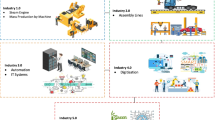Abstract
A Kanban system facilitates lean principles in a simple and effective way. While reportedly successful in many manufacturing firms, the conventional Kanban systems using physical cards suffer from human errors, limited tracking capability, and so on. To make the information flow leaner, software providers add new features to their existing programs for manufacturing systems to computerize Kanban activities. As Web-based technologies advance rapidly, developing an entirely Web-based Kanban system appears to be feasible and promising. This paper presents the advantages, limitations, and challenges of Web-based Kanban systems. An experimental program has been developed based on PHP+MySQL, a popular Web programming platform. The server-executed program features cross-platform compatibility, real-time tracking and performance monitoring, and greatly enhanced information contents compared to physical Kanbans. Human errors are minimized by the automated transactions; nevertheless, the interfacing and data maintenance require further research efforts.
Similar content being viewed by others
References
Monden Y (1998) Toyota production system: an integrated approach to just-in-time, 3rd edn. Institute of Industrial Engineers, Norcross, GA
Levy DL (1997) Lean production in an international supply chain. Sloan Manage Rev 38(2):94–102
Liker JK, Wu YC (2000) Japanese automakers, U.S. suppliers and supply-chain superiority. Sloan Manage Rev 42(1):81–93
Cutler TR (2005) E-Kanban: a key to lean. Automation.com Articles and White Papers (http://www.automation.com)
Cutler TR (2005) Dis“card”ing the paper Kanban: electronic Web-based Kanbans support lean manufacturing. InMFG 62:30–31
Drickhamer D (2005) The Kanban e-volution. Mater Handling Manage 60:24–26
Osborne T (2002) Internet Kanban delivers just in time. Illinois Manufacturer Magazine March/April:9,27
Womack JP, Jones DT (1996) Lean thinking. Simon and Shuster, New York
Monden Y (1983) Toyota production system: practical approach to production management. Institute of Industrial Engineers, Norcross, GA
Sarker BR (1989) Simulating a just-in-time production system. Comput Ind Eng 16:127–137
Siha S (1994) The pull production system: modeling and characteristics. Int J Prod Res 32:933–949
Spearman ML, Woodruff DL, Hopp WJ (1990) CONWIP: a pull alternative to Kanban. Int J Prod Res 28:879–894
Sipper D, Bulfin RL Jr. (1997) Production planning, control, and integration. McGraw-Hill, New York
Hopp WJ, Spearman ML (2000) Factory physics: foundations of manufacturing management. McGraw-Hill, New York
Wan H (2006) Measuring leanness of manufacturing systems and identifying leanness target by considering agility. Doctoral Dissertation, Virginia Polytechnic Institute and State University, Blacksburg, VA
Bell S (2006) Lean enterprise systems: using IT for continuous improvement. Wiley, New York
Cullen TJ (2002) Toyota speeds parts delivery with e-Kanban. Automotive News October:1–2
Chung C, Peng Q (2004) The selection of tools and machines on Web-based manufacturing environments. Int J Machine Tools Manuf 44:317–326
Xiong M, Tor S, Khoo L, Chen C (2003) A Web-based dynamic BOM-based available-to-promise system. Int J Prod Econ 84:133–147
Ong NS, Foo WC (2004) A real-time workflow tracking system for a manufacturing environment. Int J Prod Performance Manage 53:33–43
Overstreet J, Tzes A (1999) An Internet-based real-time control engineering laboratory. IEEE Control Sys 19(5):19–34
Weaver A, Luo J, Zhang X (1999) Monitoring and control using the Internet and Java. Proceedings of IEEE IECON, San Jose, California, November 1999, pp 1152–1158
IBM (2005) Comparing XML and relational storage: a best practices guide. IBM XML Coverpages (http://xml.coverpages.org/IBM-XML-GC34-2497.pdf)
Stopford A (2002) PHP programming for Windows. New Riders, Indianapolis, IN
Achour M, Betz F, Dovgal A, Lopes N, Olson P, Richter G, Seguy D, Vrana J (2006) PHP manual. PHP Documentation Group. (http://php.net)
Atkinson L (2002) Core MySQL. Prentice Hall, Upper Saddle River, NJ
Author information
Authors and Affiliations
Corresponding author
Rights and permissions
About this article
Cite this article
Wan, Hd., Chen, F.F. A Web-based Kanban system for job dispatching, tracking, and performance monitoring. Int J Adv Manuf Technol 38, 995–1005 (2008). https://doi.org/10.1007/s00170-007-1145-2
Received:
Accepted:
Published:
Issue Date:
DOI: https://doi.org/10.1007/s00170-007-1145-2




